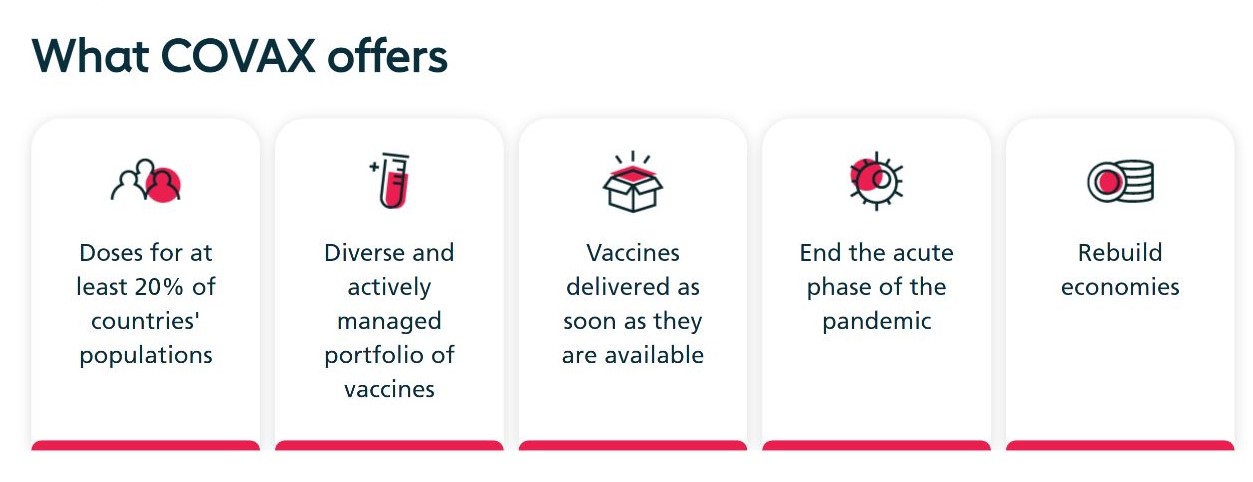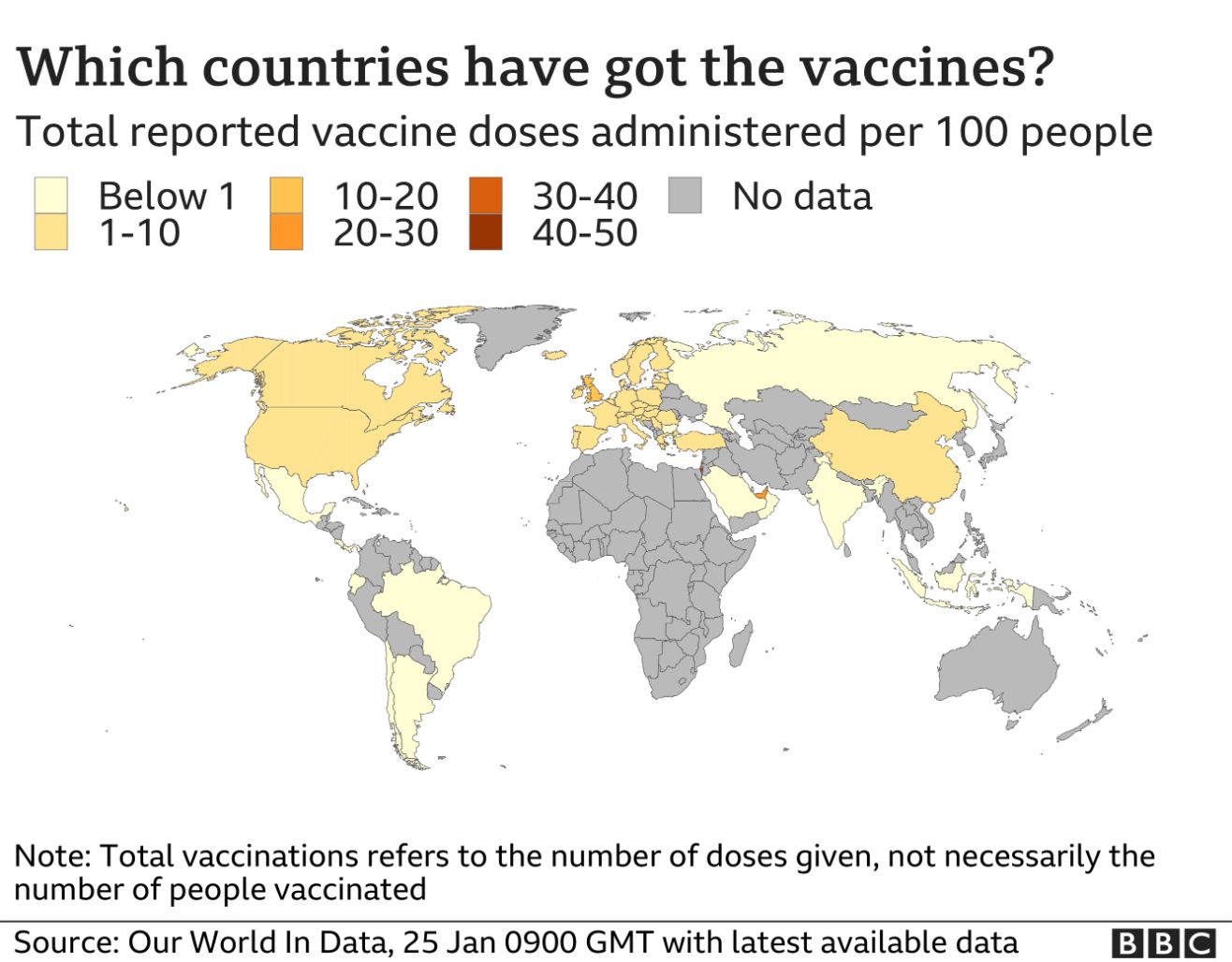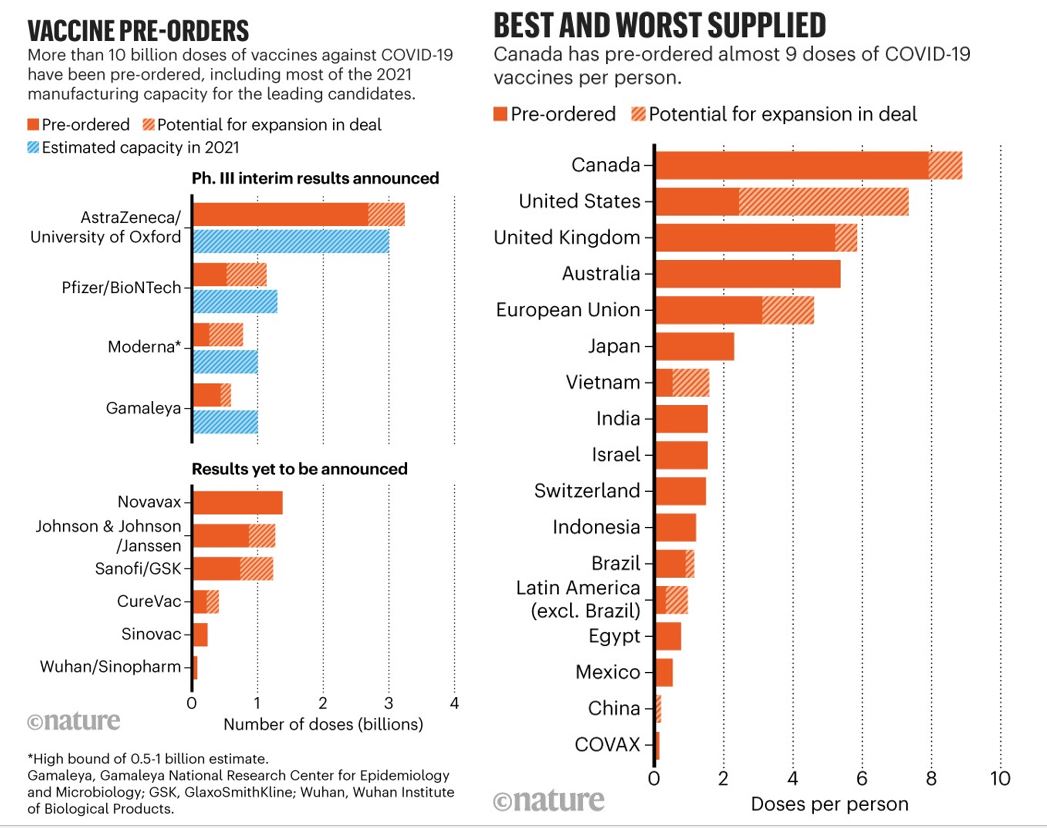On September 9, 2020, WHO announced a Fair Allocation Framework for the COVID-19 vaccine through the COVAX mechanism. This framework was set in place with good intentions to ensure the vaccines are shared equitably across all countries. According to this well-intended original plan, no participating government could procure and vaccinate more than 20% of its population until all countries had vaccinated 20%. In a follow-up phase, if limited supply persists, a weighted allocation would be adopted based on the country's threat and vulnerability. The COVAX was put in place to warrant that the price will not be an issue for the most resource-limited countries.
In practice, high-income countries (HIC) jumped on the opportunity to purchase as many doses as possible with the intention to take care of their own people in their own countries first and foremost, and do so as soon as possible, regardless of the intended 20% cut off. The intent is clear, get your hands on promising vaccines, vaccinate as many people as fast as possible, open economies, and get their own society back to normal. This action was named 'vaccine nationalism.' This results in shortening the supply to COVAX that would distribute the vaccine to low-and-middle-income countries (LMICs). While HICs initiated vaccinations in late 2020, the new estimates show that the rest of the world might not get vaccinated until late 2021, or possibly as late as 2023.
Within some countries, e.g., in Pakistan, inequities might widen between those who are able to purchase the vaccine on their own and not rely on public supply and those who have no other choice but to wait their turn, whenever that might be.
We may argue that that privileged, high-income part of the world morally and ethically failed those living in LMICs. Not surprisingly, the inability of LMIC countries to procure a sufficient amount of vaccines will lead to widened economic, social, and health inequities, and possibly security threats, halt the sustainable progress we have made over the past decades and possibly burn the trust and collaborations.
What is COVAX?
Formally known as The COVID-19 Vaccines Global Access Facility, COVAX is a global multilateral initiative coordinated by the WHO in collaboration with the Vaccine Alliance (GAVI) and the Coalition for Innovations in Epidemic Preparedness (CEPI), established in April 2020, to develop, manufacture, and deploy COVID-19 vaccines on a fair and equitable basis. It essentially functions as a funding mechanism to facilitate this process by pooling resources and purchasing power of 190 participating economies to achieve highly competitive prices.
Most countries, including 27 European Union countries, United Kingdom, Norway, Iceland, Australia, China, Japan, Singapore, Saudi Arabia, have entered into agreements with COVAX. Notably, The United States has not initially entered this agreement; however, Biden's administration decided to join the global effort and pledge $4 billion. So far, COVAX raised $6 billion and needs about 2 billion more to reach 2021 vaccination efforts. Another big donor besides the US was United Kingdom ($734 million). COVAX has built a diverse portfolio of vaccine candidates to mitigate the risk of failure at various steps of development and to ensure the suitability of a vaccine candidate for various settings.

Source: GAVI website (https://www.gavi.org/covax-facility#what)
Vaccine Supply
As of January 22, 2021, COVAX has entered into advanced purchase agreements with Pfizer-BioNTech (40 million doses), AstraZeneca (170 million doses), and Johnson & Johnson (500 million doses) and planning to fulfill its plan to distribute 1.3 billion of 2 billion doses total to eligible 92 LMIC by the end of 2021. This covers approximately 20% of the population in these countries. Countries have the flexibility to develop their own immunization priority plan, although most countries start with health care workers and older population. Negotiations with Moderna are reportedly ongoing.
Some of the first commitments for the vaccine distribution to LMICs have now been made through COVAX, e.g., Pakistan should receive 17 million doses, out of which 6 million doses are planned to be delivered by March 2021.
Current situation – reality check
A study by Duke University's Global Health Institute showed that a small number of HICs, with about 16% of the world's population, had purchased about 60% of the global vaccine supply by mid-January 2021, representing about 4.2 billion out of 7 billion doses purchased so far. Most of the HICs, Duke's study reports, purchased to cover more than 100% of their population, and some countries would be able to cover their populations several times over, e.g., Canada.
Moreover, HICs bought up all eight of the promising vaccines last year, Pfizer-BioNTech, Moderna, AstraZeneca-Oxford, Novavax, Johnson & Johnson, Sanofi-GSK, Gamaleya-Sputnik, and Sinovac, to ensure sufficient coverage if any of those would work as well as they might hope. Upper-middle income countries secured about 1.1 billion doses and lower-middle-income countries 411 million doses, and low-income countries just 270 million doses. There is a possibility that HICs will sell their supply leftover to COVAX to be distributed to eligible LMICs after these are not needed in their countries. Of course, this is not how the agreement should have played out.
Sourse: Mullard A. How COVID vaccines are being divvied up around the world
[published online ahead of print, 2020 November 30]. Nature. 2020;10.1038/d41586-020-03370-6.
doi:10.1038/d41586-020-03370-6 https://www.nature.com/articles/d41586-020-03370-6
Additionally, the global community is asking vaccine producers to share their intellectual property with the WHO's COVID-19 technology access pool, especially since some manufacturers (AstraZeneca-Oxford, Moderna, and Pfizer-BioNTech) received funding for the development of their vaccines. This might also speed up the development process and distribution of vaccines to all, including LMICs.
The figure below shows a map indicating which countries received vaccines, and it si undoubtedly centered in HICs

So, where do we stand? Simply put, due to the hoarding of COVID-19 vaccines by HICs, many LMICs might not see mass vaccinations until 2022 or even 2023, and the goal of having 70% of the world’s population vaccinated is far off. The well-intended fair distribution transitioned into 'vaccine nationalism' that might negatively affect global progress towards sustainable development and narrowing the gap of global inequities.
RESOURCES:
PUBLICATIONS:
Dyer O. Covid-19: Many poor countries will see almost no vaccine next year, aid groups warn. BMJ. 2020;371:m4809. Published 2020 December 11. doi:10.1136/bmj.m4809
Duke University Global Health Institute. "Will Low-Income Countries Be Left Behind When COVID-19 Vaccines Arrive?" November 9, 2020.https://globalhealth.duke.edu/news/will-low-income-countries-be-left-behind-when-covid-19-vaccines-arrive
Duke University Global Health Institute. "Ensuring Everyone in the World Gets a COVID Vacine" January 20, 2021. https://globalhealth.duke.edu/news/ensuring-everyone-world-gets-covid-vaccine
Emanuel EJ, Persad G, Kern A, et al. An ethical framework for global vaccine allocation. Science. 2020;369(6509):1309-1312. doi:10.1126/science.abe2803
Jain, V. Center for Global Development. The Domestic Allocation Of COVID-19 Vaccines in Low-and Middle-Income Countries, Who Goes First? November 25, 2020. https://www.cgdev.org/blog/domestic-allocation-covid-19-vaccines-low-and-middle-income-countries-who-goes-first
Liu Y, Salwi S, Drolet BC. Multivalue ethical framework for fair global allocation of a COVID-19 vaccine. J Med Ethics. 2020;46(8):499-501. doi:10.1136/medethics-2020-106516
Mullard A. How COVID vaccines are being divvied up around the world [published online ahead of print, 2020 November 30]. Nature. 2020;10.1038/d41586-020-03370-6. doi:10.1038/d41586-020-03370-6 https://www.nature.com/articles/d41586-020-03370-6
World Health Organization. Global equitable access to COVID-19 vaccines estimated to generate economic benefits of at least US$ 153 billion in 2020–21, and US$ 466 billion by 2025, in 10 major economies, according to new report by the Eurasia Group. December 3, 2020. https://www.who.int/news/item/03-12-2020-global-access-to-covid-19-vaccines-estimated-to-generate-economic-benefits-of-at-least-153-billion-in-2020-21
OTHER RESOURCES:
COVAX: https://www.who.int/initiatives/act-accelerator/covax
GAVI. The Vaccine Alliance. New collaboration makes further 100 million doses of COVID-19 vaccine available to low- and middle-income countries. https://www.gavi.org/news/media-room/new-collaboration-makes-further-100-million-doses-covid-19-vaccine-available-low
World Health Organization (WHO) resources on COVID-19 Vaccine: https://www.who.int/emergencies/diseases/novel-coronavirus-2019/covid-19-vaccines
Columbia University. "Is a global rights-based COVI-19 vaccine roll out possible?" December 9, 2020. Recording at: https://youtu.be/GQHRGmqqwyc
